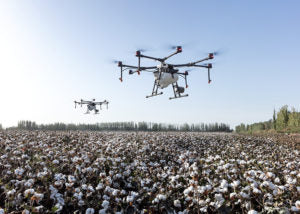The use of drones is officially legal in India, which is a boon for several sectors including security, agriculture, construction, energy and others. For example, drones can be used to survey land, buildings or transmission wires. They can also be used for search and rescue, or to map roads or traffic, drop objects (like medicine or supplies) in remote locations, spray pesticides on farms, and more.
 The legality of drone operation is proving to be a great moment for a team of students from the IT engineering program at the Institute of Computing Technology in Pune, India. The students – who called themselves Team Dronebolt – created two drones and an algorithm that is capable of coordinating eight or nine drones while flying together.
The legality of drone operation is proving to be a great moment for a team of students from the IT engineering program at the Institute of Computing Technology in Pune, India. The students – who called themselves Team Dronebolt – created two drones and an algorithm that is capable of coordinating eight or nine drones while flying together.
The advantage of multiple drones working together is that if one fails, the others can fill in any gaps in the data obtained, for example. Of course, with higher levels of operational complexity (such as multiple use of drones), there are increased levels of risk.
While the idea of synchronized drone use is not entirely new, the team says the algorithm produced is unique. “Existing drones are composed of a master, but there are numerous limitations and the chances of failure are high,” explains Siddhant Nikumbh (19), Dronebolt Team leader. “If the master fails, the entire system lags. But we created a kind of virtual node, which acts as a master.”
Nikumbh has worked with Mohit Arora (19), Japjyot Gulati (20), Pallavi Dadape (19), Ashwin Kotgire (19) and Prajakta Lanje (19).
According to Team Dronebolt, they have ensured that the chances of failure are zero because there is a virtual connection that essentially serves as the master drone. It seems that others agree. The judges at the grand finale of the Smart India Hackathon hardware edition, organized by REVA University in Bengaluru, awarded the team a win and Rs 1 lakh for their work.
“All the mistakes were made by the best teachers,” says Nikumbh. So what's in your drones? A recording camera that temporarily stores data on a single-board computer device, Raspberry Pi. Students also created an Apache web server where all data is transferred.
To ensure proper mapping of the flight area, the team implemented a simultaneous localization and mapping algorithm (SLAM). Thanks to the Raspberry Pi model V2 camera, it can take photos from up to two hectares away. With upgrades, even greater distances and accuracies are possible. Furthermore, drones can be modified based on different use cases.
Determined to succeed, each student contributed Rs 25,000 to fund the project, which cost them Rs 1.5 lakh in total. They looked to several journals and online sources for information about drones, including YouTuber Dennis Baldwin. He regularly showcases his robotics and drone work on Painless360 as well as other YouTube channels.
“For the APIs used in device development… we somehow went through all the API operations and figured out how to use them,” says Nikumbh.
Since winning the Hackathon, Team Dronebolt is preparing to participate in another competition at the Indian Institute of Crafts and Design, coordinated by AICTE. AICTE is the All India Council for Technical Education, a statutory body and a national level council for technical education under the Department of Higher Education.
Students also plan to work on more advanced drones, including object delay and manned drones. They also listened to the government of India.
“We are in contact with a government official and working safely. At the moment, we have three to four proposals, which will be selected”, says Nikumbh.

